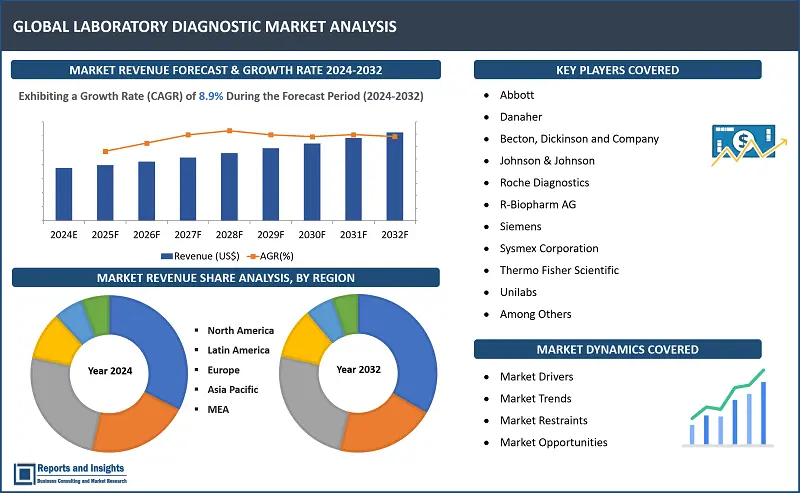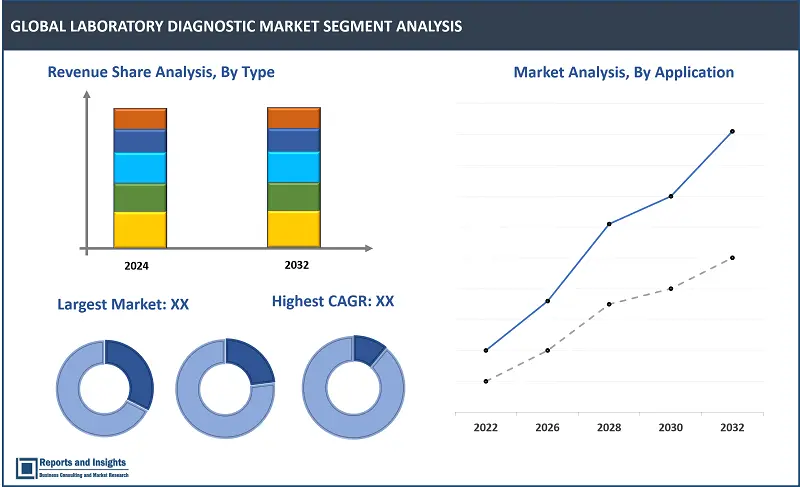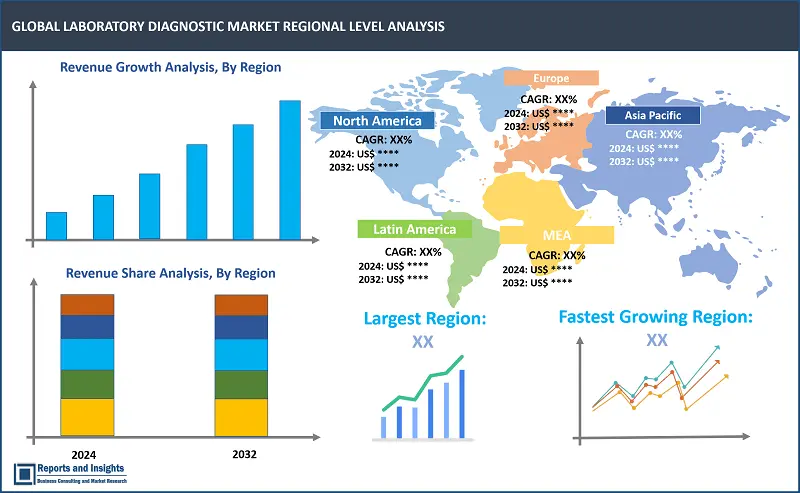Market Overview:
"The laboratory diagnostic market was valued at US$ 72.3 Billion in 2023, and is expected to register a CAGR of 8.9% over the forecast period and reach US$ 155.7 Bn in 2032."
|
Report Attributes |
Details |
|
Base Year |
2023 |
|
Forecast Years |
2024-2032 |
|
Historical Years |
2021-2023 |
|
Market Growth Rate (2024-2032) |
8.9% |
Laboratory diagnostics involve the use of medical tests and analysis of bodily fluids, tissues, and other substances to diagnose, monitor, and treat diseases. These tests are conducted in clinical laboratories by trained professionals using specialized equipment and techniques. They encompass a wide array of tests, including blood tests, urine tests, genetic tests, and imaging studies like X-rays and MRIs. These tests provide crucial information to healthcare providers, assisting in the precise diagnosis and management of various medical conditions. They are essential in preventive healthcare, early disease detection, and treatment monitoring. Advancements in laboratory diagnostics, such as automation and molecular testing, continually enhance the speed, accuracy, and efficiency of disease diagnosis, ultimately leading to improved patient outcomes.
The laboratory diagnostics market is characterized by its dynamic nature, fueled by advancements in technology, increased healthcare spending, and the rising incidence of chronic and infectious diseases globally. It comprises various products and services, including diagnostic instruments, reagents, consumables, and software. Key market segments include clinical chemistry, immunoassays, molecular diagnostics, hematology, and microbiology. Factors such as the rising demand for personalized medicine, a focus on preventive healthcare, and the growing adoption of point-of-care testing contribute to the market's growth.

Laboratory Diagnostic Market Trends and Drivers:
The laboratory diagnostic market is witnessing significant trends and drivers that are influencing its growth trajectory. One notable trend is the increasing integration of automation and digitalization into laboratory processes, which is improving operational efficiency and accuracy. Another trend is the growing demand for personalized medicine, fueling the need for advanced diagnostic techniques like molecular diagnostics. Moreover, there is a rising emphasis on preventive healthcare, leading to higher demand for routine diagnostic testing. Factors such as the rising incidence of chronic and infectious diseases, continuous technological advancements, and the expansion of point-of-care testing are also playing crucial roles in shaping the market landscape. These trends and drivers collectively contribute to the evolution and expansion of the laboratory diagnostic market, driving innovation and market growth.
The laboratory diagnostic market is influenced by various factors which include increased rates of chronic and infectious diseases drive demand for diagnostic tests, while the expanding elderly population, prone to health issues, also boosts market growth. Economic factors such as healthcare spending and reimbursement policies play a role. Additionally, growing awareness of early disease detection and the trend toward personalized medicine are influencing the market. Regulatory demands and the availability of skilled professionals are also important considerations shaping market trends.
Laboratory Diagnostic Restraining Factors:
The laboratory diagnostic market faces several restraining factors. One major challenge is the high cost of advanced diagnostic technologies and equipment, which restricts their accessibility, especially in developing regions. Stringent regulatory requirements for test approval and quality assurance also hinder market growth. Limited reimbursement policies for specific tests and a shortage of skilled professionals to operate complex equipment further restrain the market. Additionally, healthcare providers' reluctance to adopt new technologies due to concerns about their reliability and effectiveness presents a challenge to market expansion. These factors collectively impede the laboratory diagnostic market's growth potential.
Laboratory Diagnostic Market Opportunities:
The laboratory diagnostic market is expanding rapidly, fueled by advancements in technology, a growing incidence of chronic and infectious diseases, and rising demand for precise and early diagnosis. Increased healthcare spending, growing awareness of preventive healthcare, and the emergence of personalized medicine are also driving market growth. Opportunities for innovation and expansion, particularly in point-of-care testing, molecular diagnostics, and digital health technologies, are expected as the market continues to evolve.
Laboratory Diagnostic Market Segmentation:

By Type
- Drug Testing
- Clinical Chemistry Analysis
- Immunoassay
- Hematology Analysis
- Urinalysis
- Molecular Diagnostics
- Others
The type segment is further categorised into drug testing, clinical chemistry analysis, immunoassay, hematology analysis, urinalysis, molecular diagnostics and others. Among these, molecular diagnostics is the leading sub-segment in the laboratory diagnostic market, primarily driven by technological advancements such as nucleic acid amplification, sequencing technologies, and polymerase chain reaction (PCR) techniques. This segment is extensively used for detecting and monitoring infectious diseases, genetic disorders, and cancer, among other conditions. Its capability to offer quick and precise results has propelled its dominance in the laboratory diagnostic market.
By Application
- Clinical Research Organizations (CROs)
- Clinics and Hospitals
The application segment is further categorised into clinical research organizations (CROs), and clinics and hospitals. Among these, the dominant sub-segment is clinics and hospitals. These healthcare facilities are major users of laboratory diagnostic services, employing them for various purposes such as disease diagnosis, treatment monitoring, and overall patient care. The demand for laboratory diagnostics in clinics and hospitals stems from the necessity for precise and timely diagnostic information to inform clinical decisions.
By Region

North America
- United States
- Canada
Europe
- Germany
- United Kingdom
- France
- Italy
- Spain
- Russia
- Poland
- Benelux
- Nordic
- Rest of Europe
Asia Pacific
- China
- Japan
- India
- South Korea
- ASEAN
- Australia & New Zealand
- Rest of Asia Pacific
Latin America
- Brazil
- Mexico
- Argentina
Middle East & Africa
- Saudi Arabia
- South Africa
- United Arab Emirates
- Israel
- Rest of MEA
North America and Europe are leading the laboratory diagnostic market, thanks to their advanced healthcare infrastructure, widespread adoption of cutting-edge diagnostic technologies, and substantial investments in research and development. The Asia-Pacific region is also emerging as a key player in this market, fueled by factors like escalating healthcare expenditure, growing awareness of preventive healthcare, and a rising incidence of chronic and infectious diseases. Government initiatives aimed at enhancing healthcare accessibility and quality are further propelling market growth in these regions.
Leading Laboratory Diagnostic Key Players & Competitive Landscape:
The laboratory diagnostic market is highly competitive, with several key players vying for market share and actively engaging in strategic initiatives. These companies focus on product innovation, technological advancements, and expanding their product portfolios to gain a competitive edge. These companies are continuously investing in research and development activities to enhance their product offerings and cater to the evolving needs of customers in terms of efficiency, performance, and sustainability.
These companies include:
- Abbott
- Danaher
- Becton, Dickinson and Company
- Johnson & Johnson
- Roche Diagnostics
- R-Biopharm AG
- Siemens
- Sysmex Corporation
- Thermo Fisher Scientific
- Unilabs
- Among Others
Laboratory Diagnostic Research Scope
|
Report Metric |
Report Details |
|
Market size available for the years |
2021-2023 |
|
Base Year |
2023 |
|
Forecast Period |
2024-2032 |
|
Compound Annual Growth Rate (CAGR) |
8.9% |
|
Segment covered |
Type, Application, and regions. |
|
Regions Covered |
North America: The U.S. & Canada Latin America: Brazil, Mexico, Argentina, & Rest of Latin America Asia Pacific: China, India, Japan, Australia & New Zealand, ASEAN, & Rest of Asia Pacific Europe: Germany, The U.K., France, Spain, Italy, Russia, Poland, BENELUX, NORDIC, & Rest of Europe The Middle East & Africa: Saudi Arabia, United Arab Emirates, South Africa, Egypt, Israel, and Rest of MEA |
|
Fastest Growing Country in Europe |
The U.K. |
|
Largest Market |
North America |
|
Key Players |
Abbott, Danaher, Becton, Dickinson and Company, Johnson & Johnson, Roche Diagnostics, Siemens, R-Biopharm AG, Sysmex Corporation, Thermo Fisher Scientific and Unilabs. |
Frequently Asked Question
At what CAGR will the laboratory diagnostic market expand?
The market is anticipated to rise at 8.9% through 2032.
What is the size of the global laboratory diagnostic market in 2023?
The global laboratory diagnostic market size reached US$ 72.3 Billion in 2023.
What are some key factors driving revenue growth of the laboratory diagnostic market?
Technological advancements, increasing disease prevalence, aging population, growing awareness and focus on preventive healthcare.
What are some major challenges faced by companies in the laboratory diagnostic market?
Companies face challenges such as regulatory hurdles, market access, cost constraints, data security and privacy, and supply chain constraints.
How is the competitive landscape in the laboratory diagnostic market?
The market is competitive, with key players focusing on technological advancements, product innovation, and strategic partnerships.
What is the future outlook for the laboratory diagnostic market?
The laboratory diagnostic market is projected to expand due to technological advancements, growing need for precise and timely diagnoses, and higher incidences of chronic and infectious diseases.
How is the laboratory diagnostic market regulated?
Regulatory oversight in the laboratory diagnostic market is provided by agencies like the FDA, EMA, and CFDA, ensuring standards for product quality, safety, and efficacy.
What growth opportunities are present in the laboratory diagnostic market?
Opportunities include advancements in technology, expansion in emerging markets, and increasing focus on preventive healthcare.

